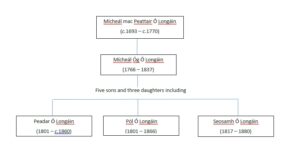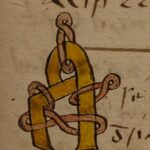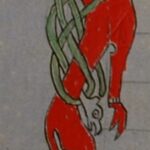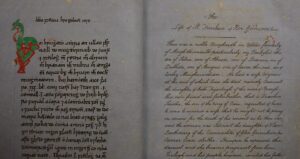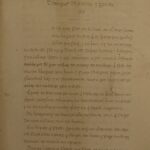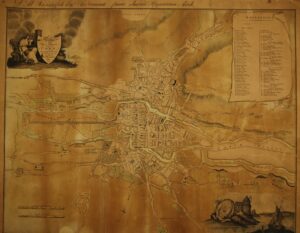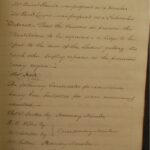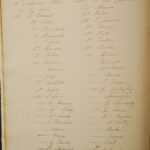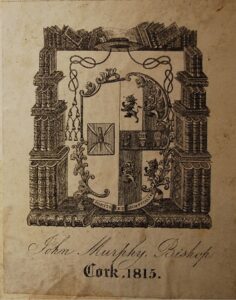The Ó Longáin Family of Scribes & Their World of Manuscripts
- Elaine Harrington
- September 9, 2015
To complement the Ó Longáin Conference recently held in UCC by the Department of Modern Irish / Roinn na Nua-Ghaeilge, material from manuscript and printed collections was selected for display cases in the Rare Books Reading Room in UCC Library’s Special Collections.
The Ó Longáin Family
From the 18th century to the late 19th century the surname ‘Ó Longáin’ was synonymous with ‘scribes.’ Working as a scribe meant copying stories, poetry, histories and religious texts from manuscripts and printed works for patrons. Working as a scribe also involved translating texts from Irish to English. Frequently their patrons were from Cork merchant families, were Cork scholars themselves such as John Windele or from Cork clergy such as Bishop John Murphy. Working as a scribe had previously been a position of privilege but as the Gaelic order disintegrated following the Flight of the Earls in 1607, scribes found their living situation growing perilous and frequently lived in poverty. Micheál mac Peattair, his son Micheál Óg and his grandson Peadar were based in Carrignavar, Cork. Grandsons Pól and Seosamh were primarily based in Dublin. Seosamh transcribed manuscript facsimiles for publication on behalf of the Royal Irish Academy. The Ó Longáin preserved a tradition and ensured access to countless texts through their scribing endeavours.
Ó Longáin Family Manuscripts
In the first display case are four manuscripts showing the work of the Ó Longáin family.
Ms. 97 which contains sermons was transcribed by Mícheál Óg Ó Longáin in 1821 in Cork. It was acquired by UCC Library in November 1949. Ms. 97 has a number of decorated initials within it.
Ms. 90 is part of the Power collection and was acquired by UCC Library in November 1941. Ms. 90 has two manuscripts bound together: “Beatha Finnchua” or “The Life of St Finchua of Bri-Golbhuinn” and “The Ancient Topography of The Two Fermoys.”
Both manuscripts are dual language texts with Irish on the left-hand side page and the English version on the right-hand side page. They are richly bound together with leather and gold-tooling on the spine and with particularly fine marbled end-papers.
Seosamh Ó Longáin transcribed “Beatha Finnchua” in 1856 for Fr. Dómhnall Ó Cathasaigh. Throughout “Beatha Finnchua” are lavishly decorated initial letters and animals in the margin.
“The Ancient Topography of the Two Fermoys” is copied from The Book of Lismore. Seoasamh Ó Longáin also copied this in 1856 for Revd. Daniel Casey. This is also dual-language in the same manner as the previous text but without any of the decorated intitial letters or animals.
Both T.xxi and T.xxxii are part of the Torna collection which was acquired in November 1949. The name of no scribe is within T.xxi but a few pages are missing from the start of the manuscript and it has been rebound in green leather. It was Torna’s opinion that Pól Ó Longáin was the scribe therefore we note that “T.xxi is in the hand of Pól Ó Longáin.” T.xxi not contain any initial letters. T.xxi contains ‘Mac na Míochomhairle’ and poetry.
Likewise no scribe is named within T.xxxii and therefore we note that T.xxxiii is in the hand of Peadar Ó Longáin. Space is left for the distinctive letters although they were not filled. in. The opening page for ‘Tóraigheacht Dhiarmada agus Ghráinne’ shows this. T.xxxii contains ‘Chronicon Scotorum,’ ‘Tóraigheacht Dhiarmada agus Ghráinne’ and poetry.
19th Century Cork
The second display case shows what 19th century Cork was like in cartographic and printed terms. William Beauford’s 1801 map of Cork City was photographed in order to show greater detail. Beauford’s map shows the river channel which ran along the course of St. Patrick’s Street completely covered over. The culverting of St Patrick’s Street had taken place between 1774 and 1789. Mallow Lane, where Donnchadh Ó Floinn copied The Book of Lismore in 1815, continues to the north of Shandon Street.
Many societies were founded in early 19th century Cork such as:
- Cork Literary and Philosophical Society: Founded 1803
- Cork Scientific Society: Founded 1813
- Cork Philosophical and Literary Society: Founded 1813
- Cork Scientific and Literary Society: Founded 1820 and sequel to Cork Philosophical & Literary Society
- Cork Cuvierian Society: 1835 – 1878
- South Munster Antiquarian Society: 1830s – 1860s
- Royal Cork Institution (RCI) 1807 – 1861
On display are both the minute books of the Royal Cork Institution (U.28) and of the Cork Scientific and Literary Society (U.275). The minute book of the Royal Cork Institution details the minutes of the managers and the proprietors. It is a veritable who’s who of Cork persons of the time.
The Royal Cork Institution was founded to be the centre for cultural, technical and scientific learning. This was later superseded through the founding of Queen’s College Cork. The Cork Scientific and Literary Society also looked to facilitate interest in knowledge ranging from antiquarianism and literature to the newly emerging technologies and sciences. The Cork Scientific and Literary Society continues to the present day.
In the third display case is material connected to 19th century Cork people: John Windele and Bishop John Murphy.
John Windele
John Windele (1801-1865) is known as an antiquarian, archaeologist, Irish scholar and writer. He was a founding member of many societies including the Cork Cuvierian Society. He edited Bolster’s Quarterly Magazine from 1826 – 1830.
Historical and Descriptive Notices of the City of Cork, and Its Vicinity: Gougaun Barra, Glengariff, and Killarney is open at p. 36 – 37 to show a reference to ‘Mallow Lane.’ The Historical and Descriptive Notices contain sections on streets, churches, trades and markets, theatres, educational institutes such as the Royal Cork Institution and the Cork Scientific and Literary Society, individuals such as the sculptor John Hogan, as well as periodicals such as Bolster’s Quarterly Magazine. Later in the volume on p. 105 Windele notes that in 1834 returns there were 39 bookbinders present in Cork and 21 booksellers and stationers.
Bishop John Murphy
Bishop John Murphy (1772 – 1847) was born in Cork City to John Murphy, a wealthy merchant in the leather and tanning business. John Murphy went to the Irish College in Paris in 1787 with the intent of study for the priesthood, however unrest in Paris forced a move to Lisbon where in 1796 he was ordained in the Irish College. He returned to Cork as a curate and priest in the middle parish (SS Peter & Paul). In 1814 he became archdeacon and in 1815 became Bishop of Cork. He remained in this position until his death in 1847. He learned Irish after becoming a bishop and through learning the language became a noted bibliophile and collector of rare manuscripts. This collection of rare manuscripts is now located in the University of Maynooth. As a bishop he was involved in many educational and charitable interests. Bishop Murphy was an early patron of the sculptor John Hogan whom he employed to decorate the Catholic Cathedral, the ‘North Chapel, in Cork.
Machtnuig go maih air: no, Leirsmuainte air fhirine mhor an chreidiu chriosduvuil, do gachla anso mioy contains Bishop Murphy’s bookplate. This indicates that this volume was part of his personal library. Machtnuig go maih air is the translation of Richard Challoner’s book of meditations Think Well On’t (1728). Challoner is best known for his revision of the Douay Rheims translation of the Bible.
Dómhnald Ó Súilliobhain dedicates the translation of Searc-leanmhain Chriost: i gceithre leabhraibh to Bishop John Murphy. Dómhnald Ó Súilliobhain a noted Irish scholar, was CC Bandon 1822-45 and PP Enniskeane 1845-58. Searc-leanmhain Chriost is the Irish translation of The Imitation of Christ (c.1418-1427). Thomas à Kempis (c. 1380 – 25 July 1471) is purported to be the author of The Imitation of Christ, one of the best known Christian books on devotion. It was first composed in Latin and is a handbook for spiritual life arising from the ‘Devotio Moderna’ movement. ‘Devotio Moderna’ is a movement for religious reform through the rediscovery of genuine pious practices such as humility, obedience and simplicity of life.
Other Exhibition on Ó Longáin Family
In Dublin the Royal Irish Academy’s exhibition on the Ó Longáin family “Scribing for Ireland: The Ó Longáin Family and the Royal Irish Academy” runs from 24 August – 20 October 2015.
Bibliography of Material on Display
- Manuscripts: Ms. 90 and Ms.97; T.xxi and T.xxxii.
- William Beauford’s 1801 map of Cork City.
- Minute book of the Cork Scientific and Literary Society (U.275).
- Minute book of the Royal Cork Institute (U.28).
- Bolster’s Quarterly Magazine
- Windele, John. Historical and Descriptive Notices of the City of Cork, and Its Vicinity: Gougaun Barra, Glengariff, and Killarney. Cork: Messrs. Bolster, 1840.
- Challoner, Richard. Machtnuig go maih air: no, Leirsmuainte air fhirine mhor an chreidiu chriosduvuil, do gach la anso mioy sgriovha roive seo a mbearla le Ristard Challenor; agus aistriyhe go Gaoyailge le Padruig Din[sic]. Gcluain-Meala: Seayan A’Caoy, 1819.
- Searc-leanmhain Chríost: i gceithre leabhraibh le Tomás a Cempis. Aisdrighthe ua’n Laidion mbunúdhasach & cómheasta go dúthrachdach leis na mac-leabhraibh is fearr teisd & is áairde céim a bhFraincis agus i Sacs-Bhéarla leis an tAthair Dómhnald ó Súilliobhain. Baile Atha Claith: clódh-bhrailte le Riostard O Loin …, 1822.
Further Information on the Manuscripts and Scribes
De Brún, Pádraig A. Clár Lámhscríbhinní Gaeilge Choláiste Ollscoile Chorcaí: Cnuasach Thorna. Baile Átha Cliath: Cló Bhréanainn, 1967.
Ó Conchúir, Breandán. Scríobhaithe Chorcaí: 1700-1850. Baile Átha Cliath Clóchomhar, 1982.
Ó Longáin, Mícheál Óg (Michael Long) (1766–1837), scribe, poet, and schoolteacher. Dictionary of Irish Biography.
Ó Longáin, Seosamh (Long, O’Longan, Joseph) (1817–80), scribe and teacher. Dictionary of Irish Biography.
O’Neill, Timothy. The Irish Hand: Scribes and Their Manuscripts from the Earliest Times. Cork: Cork UP, in association with the Keough Naughton Notre Dame Centre, Dublin, 2014.
